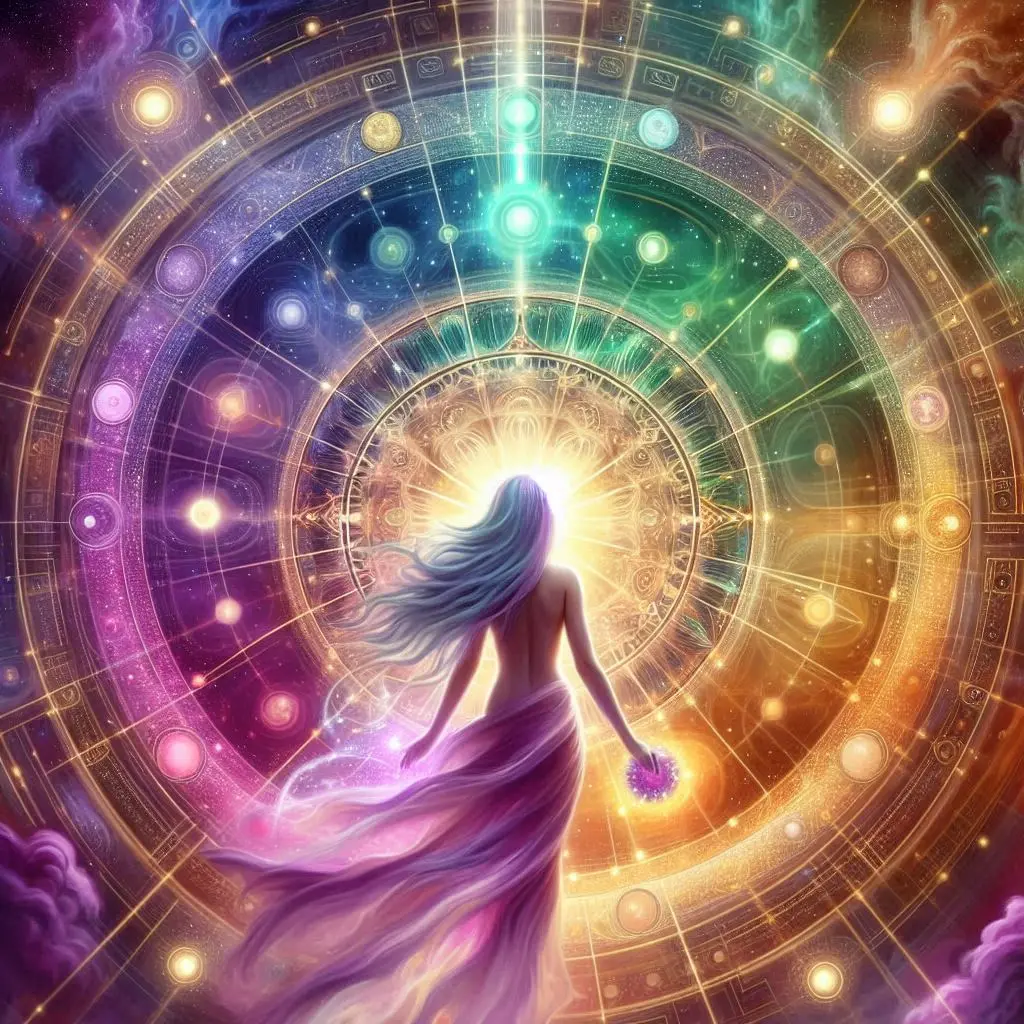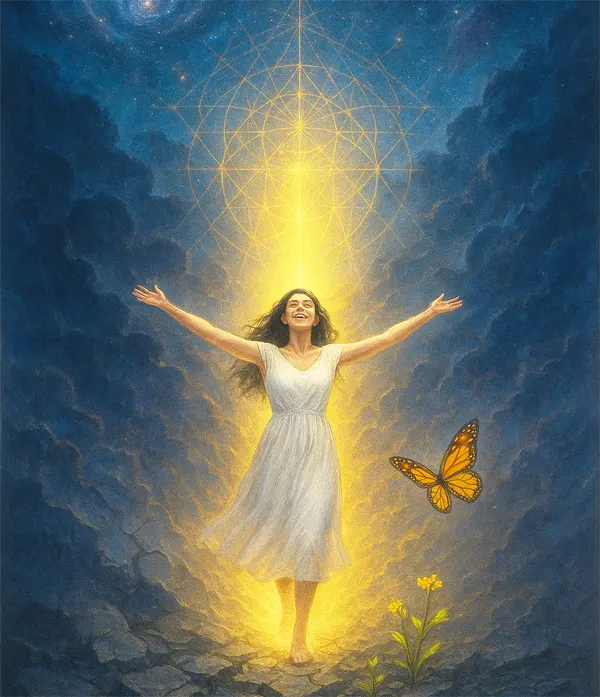The History of Akashic Records: From Ancient Wisdom to Modern Practice
Published January 10, 2025

Table of Contents
- The History of Akashic Records: From Ancient Wisdom to Modern Practice
- The Sanskrit Origins: Akasha and the Fifth Element
- The Theosophical Bridge: East Meets West
- Rudolf Steiner and Anthroposophy
- Edgar Cayce: The Modern Pioneer
- The Hindu Vedantic Tradition
- Buddhist Contributions: The Alaya-Vijnana
- Indigenous and Shamanic Traditions
- The 20th Century Renaissance
- Contemporary Practice Evolution
- Scientific and Quantum Perspectives
- Global Cultural Integration
- The Evolution of Practice
- Contemporary Challenges and Opportunities
- The Future of Akashic Records
- Conclusion: An Eternal Wisdom for Modern Times
- The History of Akashic Records: From Ancient Wisdom to Modern Practice
- The Sanskrit Origins: Akasha and the Fifth Element
- The Theosophical Bridge: East Meets West
- Rudolf Steiner and Anthroposophy
- Edgar Cayce: The Modern Pioneer
- The Hindu Vedantic Tradition
- Buddhist Contributions: The Alaya-Vijnana
- Indigenous and Shamanic Traditions
- The 20th Century Renaissance
- Contemporary Practice Evolution
- Scientific and Quantum Perspectives
- Global Cultural Integration
- The Evolution of Practice
- Contemporary Challenges and Opportunities
- The Future of Akashic Records
- Conclusion: An Eternal Wisdom for Modern Times
The History of Akashic Records: From Ancient Wisdom to Modern Practice
The concept of the Akashic Records stretches back thousands of years, weaving through ancient spiritual traditions, mystical experiences, and modern metaphysical practice. This cosmic library of souls has been known by many names across cultures, yet the core understanding remains remarkably consistent: there exists a divine repository of all knowledge, experience, and wisdom that transcends time and space.
The Sanskrit Origins: Akasha and the Fifth Element
The Ancient Foundation
The term "Akashic" derives from the Sanskrit word "Akasha" (आकाश), which literally means "space," "sky," or "ether." In ancient Hindu cosmology, Akasha represents the fifth element – the fundamental substance from which all physical reality emerges and to which it returns.
The earliest references to Akasha appear in the Vedas, ancient Sanskrit texts dating back 3,500 years. The Rigveda describes Akasha as:
"The imperishable, eternal principle from which all things are born and into which they dissolve."
The Philosophical Development
Ancient Indian philosophers developed sophisticated understandings of Akasha:
Samkhya Philosophy: Described Akasha as the subtle element of sound, the medium through which all vibrations travel
Advaita Vedanta: Understood Akasha as the field of pure consciousness in which all experiences arise
Yoga Traditions: Recognized Akasha as the space element within the human energy system, associated with the throat chakra
The Theosophical Bridge: East Meets West
Helena Blavatsky's Revelation
The concept of Akashic Records was first introduced to Western audiences in the late 19th century through the Theosophical Society, founded by Helena Petrovna Blavatsky. In her groundbreaking work "The Secret Doctrine" (1888), Blavatsky described the "Astral Light" – a cosmic memory that preserves the impressions of all events.
Blavatsky's teachings suggested that:
- All thoughts, actions, and events leave permanent impressions in the astral plane
- These impressions can be accessed by those with developed psychic abilities
- The records contain the complete history of human evolution and cosmic development
The Theosophical Interpretation
Early Theosophists developed a systematic understanding of the Records:
Alfred Percy Sinnett: Described how advanced masters could read the "imperishable records" to understand historical events
Charles Webster Leadbeater: Provided detailed descriptions of how the Records appear to clairvoyant perception
Annie Besant: Connected the Records to the evolution of human consciousness and spiritual development
Rudolf Steiner and Anthroposophy
The Scientific Spiritual Approach
Rudolf Steiner (1861-1925), founder of Anthroposophy, brought a scientific rigor to understanding the Akashic Records. Unlike purely mystical approaches, Steiner treated Record reading as a form of spiritual research that could be developed through systematic training.
Steiner's Contributions
Methodical Development: Created specific exercises for developing the capacity to read the Records
Historical Applications: Used Record readings to provide alternative histories of ancient civilizations
Educational Integration: Incorporated Akashic insights into Waldorf education philosophy
Scientific Framework: Attempted to bridge spiritual perception with scientific methodology
Steiner described the Records as:
"Everything that has ever happened in the world and has been experienced by human beings is preserved in imperishable form in the spiritual world. This is the Akashic Chronicle."
Edgar Cayce: The Modern Pioneer
The Sleeping Prophet's Revolution
Edgar Cayce (1877-1945) revolutionized Western understanding of the Akashic Records, though he rarely used that term, preferring "God's Book of Remembrance." Cayce's unique contribution was making Record reading practical and accessible for healing and guidance.
Cayce's Innovations
Medical Applications: Used Records to diagnose illnesses and prescribe treatments
Past-Life Integration: Connected current life challenges to past-life experiences
Practical Guidance: Provided specific advice for daily life decisions
Documented Evidence: Left behind 14,306 recorded readings for research and study
The Hindu Vedantic Tradition
The Eternal Library Concept
Hindu philosophy has long recognized the concept of cosmic memory through various frameworks:
The Chitta: Universal consciousness that stores all experiences and impressions
Samskaras: Mental impressions that carry forward through lifetimes
The Cosmic Mind: The universal repository of all knowledge and experience
Sacred Texts and References
Ancient Hindu texts contain numerous references to cosmic records:
Bhagavata Purana: Describes how divine beings can perceive all of time simultaneously
Yoga Vasistha: Explains how consciousness contains all possible experiences
Advaita Vedanta: Teaches that individual consciousness is part of universal consciousness containing all knowledge
Buddhist Contributions: The Alaya-Vijnana
The Storehouse Consciousness
Buddhism developed the concept of Alaya-Vijnana or "storehouse consciousness" – a foundational awareness that contains the seeds of all experiences and potentials. This Buddhist understanding parallels the Akashic Records concept in several ways:
Universal Repository: Contains the impressions of all actions and experiences
Karmic Storage: Preserves the consequences of actions across lifetimes
Collective Aspect: Individual storehouse consciousness connects to universal consciousness
Transformational Potential: Understanding this consciousness facilitates liberation
Historical Development
The Alaya-Vijnana concept evolved through various Buddhist schools:
Yogacara School: Developed detailed theories about consciousness and memory storage
Tibetan Buddhism: Integrated the concept into practices for navigating between lifetimes
Zen Tradition: Used similar concepts in understanding universal mind
Indigenous and Shamanic Traditions
Universal Patterns Across Cultures
Long before formal concepts of Akashic Records emerged, indigenous cultures worldwide recognized similar principles:
Native American Traditions
Vision Quests: Accessing cosmic wisdom through spiritual journeying
Ancestral Wisdom: Understanding that ancestral knowledge remains accessible
Medicine Wheels: Representing the cyclical nature of time and experience
Oral Traditions: Preserving cosmic stories and universal wisdom
African Traditions
Ancestral Communication: Direct contact with the wisdom of those who have passed
Ubuntu Philosophy: Recognition of universal interconnectedness
Griot Traditions: Preserving collective memory through storytelling
Australian Aboriginal Traditions
Dreamtime: The eternal realm where all stories and wisdom exist simultaneously
Songlines: Energetic pathways that connect all places and times
Ancestor Spirits: Ongoing access to ancestral wisdom and guidance
The 20th Century Renaissance
The New Thought Movement
The early 1900s saw renewed interest in mystical and metaphysical concepts:
Edgar Cayce: Brought practical applications to Record reading (1901-1944)
Alice Bailey: Developed systematic teachings about spiritual evolution through the Records
Max Heindel: Connected Record reading to astrological and cosmic cycles
Mid-Century Developments
Gina Cerminara: "Many Mansions" (1950) popularized Cayce's reincarnation concepts
Ruth Montgomery: "Here and Hereafter" (1968) brought Record concepts to mainstream audiences
J.J. Hurtak: "The Keys of Enoch" (1973) provided cosmic perspectives on Record access
Contemporary Practice Evolution
The Democratization of Access
Modern teachers have made Akashic Records reading accessible to ordinary people:
Linda Howe: Developed systematic training programs and the Pathway Prayer
Maureen St. Germain: Created structured methodologies for personal Record access
Akashic Records Teachers: Worldwide network of certified instructors
Integration with Other Modalities
Contemporary practice often combines Record reading with:
Energy Healing: Reiki, chakra balancing, and crystal therapy
Psychological Approaches: Therapy, counseling, and personal development
Holistic Health: Nutrition, bodywork, and wellness practices
Spiritual Development: Meditation, yoga, and consciousness expansion
Scientific and Quantum Perspectives
Modern Physics Connections
Contemporary scientists have proposed frameworks that might explain Record phenomena:
Quantum Field Theory: Information preservation in quantum fields
Morphic Resonance: Rupert Sheldrake's theory of collective memory
Consciousness Research: Studies on non-local consciousness and information access
Holographic Universe Theory: Reality as information stored in holographic patterns
Research Developments
Institute of Noetic Sciences: Studies consciousness and information access
University Research: Academic studies on consciousness and memory
Medical Applications: Exploring Record-informed healing approaches
Psychological Studies: Research on past-life memory and therapeutic applications
Global Cultural Integration
Eastern and Western Synthesis
Modern Akashic Records practice represents a unique synthesis:
Eastern Wisdom: Foundational concepts from Hindu and Buddhist traditions
Western Methodology: Systematic approaches and practical applications
Scientific Inquiry: Attempts to understand mechanisms and validate experiences
Therapeutic Integration: Combination with healing and counseling practices
Cross-Cultural Recognition
Similar concepts appear across cultures:
Celtic Traditions: The Otherworld as a realm of all knowledge
Egyptian Mysteries: The Hall of Records in the Great Pyramid
Mayan Cosmology: The cosmic tree containing all wisdom
Persian Zoroastrianism: The cosmic library of Ahura Mazda
The Evolution of Practice
Historical Phases
Phase 1: Ancient Recognition (3500 BCE - 1800 CE)
- Mystical understanding in various cultures
- Limited access for spiritual adepts
- Cultural-specific interpretations
Phase 2: Western Introduction (1800-1950)
- Theosophical revelation
- Edgar Cayce's innovations
- Systematic documentation
Phase 3: Popularization (1950-2000)
- Public education and books
- New Age integration
- Therapeutic applications
Phase 4: Democratization (2000-Present)
- Accessible training programs
- Online learning opportunities
- Integration with other modalities
Modern Characteristics
Today's Akashic Records practice typically includes:
Accessible Methods: Techniques anyone can learn
Ethical Frameworks: Guidelines for responsible practice
Integration Approaches: Combination with other healing modalities
Scientific Curiosity: Attempts to understand and validate the phenomenon
Contemporary Challenges and Opportunities
Challenges
Commercialization: Risk of reducing sacred practice to commodity
Lack of Standardization: Varying quality in training and practice
Scientific Skepticism: Difficulty proving Record phenomena
Cultural Appropriation: Need for respectful honoring of origins
Opportunities
Global Accessibility: Worldwide availability of training and practice
Integration Potential: Combination with established therapeutic approaches
Research Possibilities: Growing scientific interest in consciousness studies
Healing Applications: Therapeutic potential for trauma and personal development
The Future of Akashic Records
Emerging Trends
Technology Integration: Apps and digital tools for Record work
Medical Applications: Integration with holistic healthcare
Educational Systems: Inclusion in consciousness studies curricula
Research Programs: Academic investigation of Record phenomena
Potential Developments
Standardized Training: Certification programs and professional standards
Scientific Validation: Research on accuracy and therapeutic benefits
Cultural Preservation: Honoring indigenous wisdom traditions
Global Practice: Worldwide community of ethical practitioners
Conclusion: An Eternal Wisdom for Modern Times
The history of Akashic Records reveals a profound truth: across cultures and throughout time, humans have recognized the existence of a cosmic library of wisdom and experience. From ancient Sanskrit concepts to modern therapeutic applications, this understanding has evolved while maintaining its essential core.
Today's practitioners stand on the shoulders of thousands of years of spiritual exploration and development. The challenge and opportunity before us is to honor this ancient wisdom while making it relevant and accessible for contemporary needs.
The Akashic Records represent more than just a historical curiosity – they offer a living tradition that continues to evolve and serve humanity's quest for understanding, healing, and spiritual growth. As we move forward, the integration of ancient wisdom with modern understanding promises even greater opportunities for personal and collective transformation.
The records themselves remind us that we are part of an eternal story, connected across time and space in ways we are only beginning to understand. This perspective transforms not just how we see our own lives, but how we understand our place in the vast cosmic tapestry of existence.


